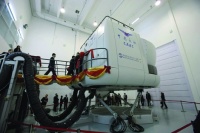
Prof Andrew Plummer has been working alongside a team at the university’s Centre for Power Transmission and Motion Control to develop methods of improving the efficiency of hydraulic fluid-power systems by as much as 50 per cent.
The group has recently been awarded £627,000 by the Engineering and Physical Sciences Research Council (EPSRC) to accelerate its work.
’Most of the hydraulic-fluid power systems used in industry lose the majority of the energy consumed,’ explained Plummer. ’The main cause of this is the use of valves that effectively throttle the flow. The build-up of pressure during this process can cause up to 80 per cent of the energy to be lost as heat.’
One approach that could solve the efficiency loss is the use of a switched reactance hydraulic transformer (SRHT). This works by using a digital valve that can switch on and off to control the average flow of the system. Linked to the valve is a tube filled with hydraulic fluid that provides enough inertia for switching to take place at around a thousand times per second. Plummer continued by saying: ’When the system is off, there’s nothing going through so there’s no power loss. The same applies when it is on because the restriction is not very great, so potentially it could be a much more efficient way of controlling the flow of hydraulic systems.’
The team is also working on a method called electro-hydrostatic actuation (EHA). The approach uses a variable-speed electric motor to drive a fixed displacement pump that directly delivers flow to a linear actuator. EHA is already proven in hydraulic systems for aviation, however, it lacks the speed of control of SRHT.
Both methods also suffer from noise problems. ’With one of our early prototypes, somebody once said it sounded like a machine gun going off,’ said Plummer. ’But if the noise and speed problems can be overcome, I believe these technologies hold a lot of promise.’










UK Enters ‘Golden Age of Nuclear’
The delay (nearly 8 years) in getting approval for the Rolls-Royce SMR is most worrying. Signifies a torpid and expensive system that is quite onerous...